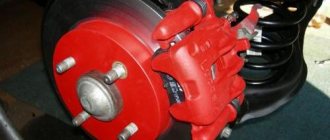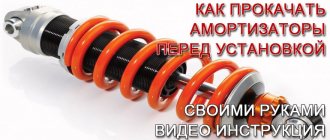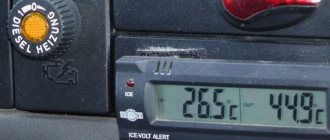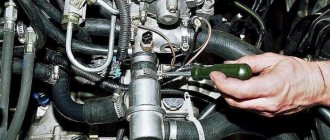In theory, you can start shoveling snow or cleaning your car with the engine running, but there is a risk of engine damage, although very small. However, there is a real danger to the engine associated with behavior such as keeping the engine idling cold, but the damage from doing so can be significant. How to prepare a car for driving so as not to damage it and why you shouldn’t put off driving after starting a cold engine in the cold?
Warming up the engine in the cold is harmful to it
Cleaning the windows and removing snow from the car takes about 10 minutes. Can an engine running without load at idle warm up during this time? Most modern engines can't! Moreover: in severe frosts of minus 10 degrees Celsius, the diesel engine will not reach operating temperature even after an hour of operation without load!
Much, however, depends on the design of the engine. Old power units, especially gasoline ones, “emitted” a lot of heat and warmed up relatively quickly. Modern engines are more efficient and therefore less energy from combustion is converted into heat, which heats the engine itself and also heats the interior of the car. Modern diesel engines have the highest efficiency, so they warm up the slowest. And one more thing: the size of the engine. The greater the power of the power supply, the more heat that can be used, among other things, to heat the car interior.
Manual heating
First, let's consider the option when you do not have a standard device for heating the engine. And after a sharp frost, your iron friend refused to start. Most often this happens for two reasons:
- On diesel engines, the fuel freezes (but gasoline also suffers from the same problem), then you are heading straight to a warm box. This is the most reliable way;
- The oil has thickened. This can often be found on gasoline engines when using oil that is not of very high quality or does not meet the climatic conditions.
If there are few ways to heat the fuel. You can deal with frozen oil quite easily. To do this you will need a blowtorch and a sheet of tin or iron. We place this sheet under the engine and direct the lamp torch at it. As a result, it will become warm enough under the car for the oil to warm up to the required conditions.
Attention!
It is not recommended to light fires under the car; the engine should only be heated with warm air.
Long-term work on a rich mixture: kill the engine!
In any case, by starting the engine at a low temperature and leaving it idling, we will force it to run for a long time on a rich mixture. Some of the fuel flows down the cylinder walls into the oil pan - just as in a diesel engine when burning soot from the particulate filter - with diesel and gasoline engines equally affected by warming up the car in the cold. The more fuel in the oil, the thinner it becomes, the lower its viscosity and the less it protects the engine during overloads. Of course, we will not break our car’s engine in this way within one season, but by regularly repeating this mistake, we lead to accelerated wear and tear. The colder it starts, the worse it gets.
Types of heating
How and with what to warm up the engine in winter before starting it yourself? To answer this question, it is advisable to decide what you need from this device. All types of heating are divided into the following groups:
- Fuel heating;
- Engine heating.
The first method is most often used on diesel units. As you know, diesel fuel can turn into a gel-like state in the cold. Therefore, fuel heating is often done. This is not necessary in gasoline engines. Heating the block itself is more efficient. This reduces the risk of damage to the piston group elements. After all, when starting the engine in the cold, the pistons heat up much faster than the block.
As a result, due to the expansion of the pistons, cylinder scuffing may occur, and the engine may seize. There are several options for heating the engine. Below we will look at how to make your own heating device.
How to safely prepare your car for the road?
First, provide visibility. Windows, at least the front and side windows, must be free of ice.
Secondly, sweep the snow off the roof. Getting a ticket for a car with a snow cap is easier than warming it up under the house, it is also much more dangerous. If snow from a car (and sometimes ice) falls on someone while driving, we may have problems going well beyond the ticket.
Third, start the engine and drive. When to start moving? If the car is in good working order and the engine does not make any unwanted noise - immediately! In practice, some engines vent the injectors slightly, while others take a few seconds to prime the hydraulic valve lifters, and before they do, they make a knocking noise. Oil reaching all lubrication points of an engine, even a new one, takes no more than a few to a few seconds. After this time, every moment of delay at the beginning of the journey is no longer justified.
Car doors are frozen, how to open them
A frozen door lock is sometimes not the only problem with doors in cold weather. It happens that the doors themselves freeze, this especially often happens after washing the car. This problem also has a solution.
- To open a frozen car door, you must proceed in the following order:
- The first step is to clean the edges of the door from snow and ice with a brush.
- After this, you need to press the edges of the door several times and try to open it. This process must be repeated 3-4 times.
- If the door still does not give way, you can use a special defrost or hair dryer.
- It is not necessary to open the driver's door first, because you can try to open any other door and start the car. Wait until the car warms up, and then the driver's door will thaw itself.
You should not try to warm the door with hot water or use knives, keys, etc. to open it. This will damage the paintwork and rubber seals. Or you can even bend the door itself.
How to warm up a car during frosts?
Definitely, the car needs to be warmed up while driving. However, you should adhere to several rules:
- especially when it's cold, you should definitely avoid driving at low speeds. The speed is so low that the drive system and engine of the vehicle, and even the entire vehicle, vibrate is unacceptable!
- high speeds close to maximum should be avoided
- You can drive the first kilometer or two at a slightly higher speed of 3000 rpm. for example, in 3rd gear.
- To speed up the warm-up of the engine, it can be additionally loaded, including consuming electricity, such as heating the rear window, mirror, seat or steering wheel
- from the first seconds of movement, the air flow should be at least partially directed towards the windshield. When we do this later, when the hot air is already being released from the ventilation grilles, the frozen glass is subject to thermal shock - it may even burst!
- If the coolant temperature indicator drops when parked at a traffic light, this is normal, and this is due to the high efficiency of the engine, which produces little heat - it simply takes more to heat the cabin than the engine can "produce" when parked at a traffic light, when running without a load.
How to properly warm up the car interior
As such, there are no strict rules for warming up the car interior; basically, there are recommendations, advice from experienced drivers or our own experience. Based on all these situations, we can conclude how best and how to properly warm up the car interior to a comfortable temperature. If you are going on a long journey in winter, and even in heavy snow, then it is imperative that all the standard interior heating systems work in the car, and there are also several additional systems for an unforeseen event.
Today, engineers install an interior heating system in every car, in some they are mechanical (conventional stove), in others they are automatic (climate control). In addition to standard equipment for warming up the interior, you can find equipment for additional heating at car markets or car stores. Mercedes cars have a rather interesting and useful REST function. The bottom line is that after stopping the engine completely, you can activate the function and warm up the car interior with the remaining heat of the unit. This function is found only with climate control, which allows you to automatically maintain the temperature and turn off the interior heating if necessary.
The first rule, or rather the advice of experienced drivers, is to warm up the engine to operating temperature and only then turn on the heater or climate control. Typically, warming up will take at least 10 minutes, during which time the interior heating system will heat up and the engine will warm up. It is better to turn the heater on to the first or second position; the air will slowly pass through the heater radiator and thereby warm up the interior well. At maximum speed, the cold air will not have time to warm up and, on the contrary, will only cool down the car interior. With climate control, warming up the interior is much better; just start the car and set the required temperature, the system will automatically adjust the fan speed to quickly warm up the interior of the car.
In winter, windows often fog up or freeze; you should not wipe the inside; to do this, it is better to direct the air flow away from the windshield and side windows. For the rear window, you need to turn on the heating, which is also included in the standard set. Modern cars can boast of having heating systems for the front, rear seats and steering wheel, and in some trim levels a heated windshield is installed.
It would not be superfluous to turn on additional interior heating systems; this will most likely not have such a strong effect on the rapid increase in temperature in the cabin as it will have a positive effect on the health of the driver and passengers. This is especially noticeable during regular daily trips, sitting in a cold interior and on cold seats, after a month, or even a couple of weeks, you can easily catch a cold in your back or other parts of the body. In this case, even with a cold ambient temperature in the cabin, warm seats and steering wheel change the situation for the better. An equally important tip is to close the dampers and close the doors tightly to limit the access of cold air into the car interior from the street, then warming up will be much more efficient and faster.
Why do some cars have efficient heating while others do not?
It's true that there are even modern, economical diesel engines that can quickly heat the interior of a large SUV or van, despite severe frosts. However, this “instant” heat is not generated by the engine - such miracles do not happen! Few cars, especially higher-shelf or high-spec versions, have additional factory-installed under-hood heaters - often combustion heaters that work on the same principle as the Webasto parking system. If there is no such device, then a small economical engine does not guarantee thermal comfort in winter, and when stopping at a traffic light, not only the temperature gauge drops, but also the internal cold part. This is not a malfunction - this guy has it!
Do you need to warm up your car in winter?
Many new car manufacturers say that you don't have to warm up your car in winter, and some even recommend not warming it up. It is not known for certain what manufacturers did to provide such information to buyers; rather, it is a marketing ploy so that car parts will fail over time. Every experienced driver understands that all liquids become thick in the cold and change their viscosity, especially when it comes to oil in the crankcase or gearbox. Cold oil is viscous and can damage parts; most often it is recommended to warm up the engine and automatic transmission to at least 40 degrees and only then start driving and turn on the heating of the car interior.
Well, the conclusion suggests itself, despite the recommendations of the manufacturer and the advice of friends, it is strongly recommended to warm up the car in winter, especially in severe frosts. This will not only preserve the car’s engine, but also warm up the interior, because in many cars, the radiator of the heating stove starts working after the engine warms up, otherwise the interior of the car will not warm up.
Disadvantages of a pre-heating engine
- Energy consumption . Regardless of the type of equipment, the device spends a lot of energy during the entire cold season. Energy consumption depends on several factors: outside air temperature; duration of required heating; regularity of travel after a long break. For a fuel device, you will have to refuel the car with gasoline or gas more often. An electrical device will waste a lot of electricity.
- Separate purchase . The additional heating system is not included with the car. You will have to install the equipment separately. For most car enthusiasts, the idea of installing a preheater for the engine comes with the onset of cold weather. If you don't take care of your heating system in advance, problems will arise.
- Price . A device for additional heating is expensive. In addition to the equipment itself, you will have to pay for installation. The cost depends on the characteristics of the car, the configuration of the device and the type of heater. Installing a basic kit will be very expensive.
- Wear and breakage . The equipment protects moving mechanisms from wear, but the device itself may fail. It is necessary to check the performance of the device annually to ensure that it functions properly throughout the winter period.
- Fakes . Due to the high cost, most motorists purchase low-quality or used equipment. Such devices work worse. The service life is much shorter.
Opinions for and against
Warm interior in winter
There are several important aspects to note:
- modern cars are equipped with a variety of “smart” electronics;
- you have to pay for warming up with high fuel consumption and toxicity;
- Finding the perfect option is quite difficult.
Firstly, warming up is more of a tradition than a really useful action. We are accustomed to the fact that in winter we need to “warm up the car” before driving. Most often, no one even thinks about usefulness.
And in fact, previously, with carburetor cars, you really had to struggle a lot to start them in the winter and achieve the required performance. Current injection models are much less demanding in this regard.
Modern injection systems are capable of automatically adjusting some engine operating parameters. In fact, “engine warming up” is carried out automatically, the system optimally distributes the load.
Engine heating
There are several layout options here. The choice of what exactly to collect depends on your skills, as well as the availability of tools.
Most often, antifreeze is heated. This method is best for quickly warming up the engine. It can also be used if it is necessary to maintain a high operating temperature of the motor. To do this you will need 2 flanges (one plastic), a heating element (a small piece of copper wire), a seal, an 80A relay and a switch.
You also need 2 meters of wire for connection and a 50 A fuse. All this is assembled and tested for functionality. Then it crashes into the engine heating system, preferably in a small circle. The most optimal place is in front of the stove radiator.
To make another fixture, you will need a plumbing tee. You also need to buy a heating element. A device for heating running water is suitable, but it must be equipped with a thermostat. A 10 cm long pipe is screwed onto one end of the tee. Plugs should be put on the remaining outlets with the possibility of connecting hoses to them. A heating element is placed in the pipe. After which the heater is connected to the engine, it is best to place it near the stove. The terminals of the heating element are connected to the battery via a relay and a switch.
Conclusion
. In our country, the climatic conditions are quite difficult. Therefore, most drivers are wondering how and with what to warm up the engine in winter before starting it with their own hands? After all, engine operation at extremely low temperatures can lead to the need for major repairs.
How to heat glass? Primitive way
How to make a car heater with your own hands? Before starting work, clean the glass from dirt. For full operation of the heater, form the surface necessary for increased current conductivity. To do this, light a candle and cover the surface of the glass with a thin layer of soot.
Carry out similar work with the next glass surface. At a distance of half a centimeter from the edge of the glass, remove the soot with a cotton swab. Cut out foil equal in size to the surface of the smoked square. In our equipment, the foil will play the role of electrodes. Apply glue to the soot and attach a cut piece of foil. Some part of the foil should protrude slightly beyond the glass. Place the second glass on top and fill the joints with sealant. The electric heater is ready for use.
How does he work
So, the technological operation of the device. In its action it resembles the work of thermal film. The heat it produces is not used to heat the air. The heat generated by the device is transferred to the objects it is directed at. In other words, objects first begin to heat up, and only then give up their energy to the air. Usually such a device is not turned on in vain. If it is in working condition, then it is intended for something. Its energy consumption is very minimal. Before you make a heater for your car, you will need to find spare parts that can be purchased on the radio market.
Required items:
- Two glasses, identical in size. The shape is rectangular. The area is about 25 sq. cm.
- Soldering iron.
- Foil.
- Paraffin candle.
- Scissors.
- A cable consisting of two cores and a plug.
- Sealant.











